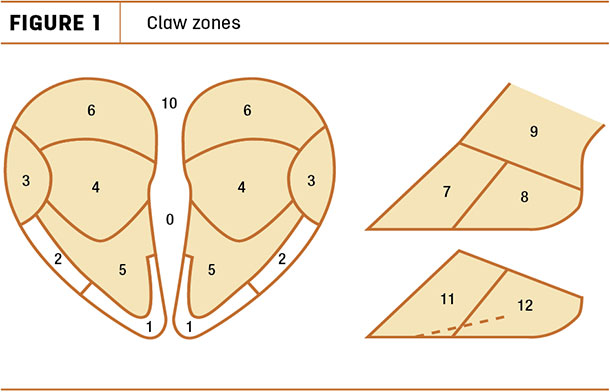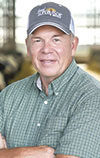When hoof trimmer Rick Trinko of Middleton, Wisconsin, began seeing a large number of cows at one dairy with white-line hemorrhages in zone 2, he was alarmed. The typical site for a white-line hemorrhage is zone 3, and it can indicate the early stages of white-line disease.
Having never seen a white-line hemorrhage in zone 2 at this farm before, Trinko decided to take a closer look at why this part of the claw was affected. He suspected crowding issues were to blame and asked the farmer to observe how his cows were being pushed with the crowd gates into the milking parlor.
Was too much pressure being placed on cows at the back of the holding pen? The answer ended up being “yes.”
If Trinko had dismissed the problem as white-line hemorrhaging without paying attention to zone location, more cows risked injury without resolving the issue. Once the farmer educated employees on proper use of the crowd gate, hemorrhages in zone 2 disappeared.
Claw zones help standardize information captured in lameness records
“Recording lesions by zone adds precision to your diagnosis,” Dr. Jan Shearer says. Shearer is a professor and extension veterinarian at the college of veterinary medicine at Iowa State University and one of North America’s leading experts on dairy cattle hoof health.

“Zone identification is especially helpful for people who don’t know specific lesion names or for multicultural persons who may not be familiar with terms in English.
Since ulcers can occur in zones 4, 5 or 6, and white-line disease may show up in zones 1, 2 or 3, it’s helpful to designate the zone as well as the lesion type in order to fine-tune your diagnosis.”
The zone scoring system divides the hoof into 12 numbered zones. Zones 1 through 6 are found on the weight-bearing part of the claw, while zone 0 represents the interdigital skin and zone 10 the interdigital cleft (a common site for hairy heel warts).
Zones 7 and 8 embody the outside hoof wall, while zones 11 and 12 denote the axial or inside wall. The dashed line specifies the white line on the axial side of the claw capsule or wall. Zone 9 is used to identify lesions of the foot skin above the coronet.
Hoof lesions commonly occur in zones 0, 3, 4 and 10. A lesion in zone 0 may indicate foot rot or digital dermatitis, whereas lesions appearing in zone 10 are most likely digital dermatitis – a highly contagious, erosive infection usually affecting the skin on the bulbs of the heel but which can also be found between the digits or in the area of the coronary band.
Lesions occurring in zone 3 represent white-line disease. Both digital dermatitis and white-line disease are major causes of lameness frequently complicated by abscess formation, which can result in serious lameness.
Zone 4 is the typical site for sole ulcers. A sole ulcer is a painful, non-infectious hoof lesion and one of the most common causes of lameness in dairy cattle. “Sole ulcers are often traced to feeding problems or issues related to cow comfort or conditions that predispose to excessive standing,” Shearer notes.
“Lesions can even tell you what kind of floors the cows are standing and walking on. If you didn’t know the zone, you could never diagnose to this extent.”
Canadian hoof trimmer Vic Daniel, of Vic’s Custom Clips, says, “Zone scoring shows you exactly where problems are located and provides accountability of why a cow cannot walk normally.”
Zone scoring improves recording consistency, uncovers root causes of lameness
Trinko and Daniel both use a chuteside data recording system that records lame events by lesion and location – specifically by zone. This program makes it quick and easy for hoof trimmers to record lameness information on every cow that enters the chute.
Using the Dairy Claw Lesion Identification system agreed upon by the International Lameness Committee, lame events are recorded by lesion name and zone location in one step.
At the end of the day, trimmers can create a pie graph depicting the allocation of problems and affected zones. “Farmers really like this,” says Trinko, a former instructor at Dairyland Hoof Care Institute. “It shows you what’s going on at the herd level.” If a cow requires immediate attention, the report will communicate this, too.
By improving the accuracy of lesion diagnosis, we get closer to determining the root cause of lameness on a dairy. When Daniel saw fairly severe sole hemorrhages in zone 6 and sole ulcers in zone 4 on one farm, he knew cows were perching because their stalls weren’t built correctly. “Just recording this as a sole hemorrhage wouldn’t reflect the real problem of perching,” Daniel says.
With more than 30 years of trimming experience under his belt, Daniel goes on to say, “The use of zones makes trimmers more confident in their work and provides tighter evaluations of our observations. Loose terms such as ulcer and hemorrhage just don’t cut it anymore.”
Zone scoring aids in treatment and prevention
Documenting lesions by zone helps address lameness at the very earliest stages and enables you to see patterns develop. Daniel says, “When I see a consistent problem in the same zone on the same animal over a one- to two-year period, I recommend my clients do not breed her back.”
By shedding light on a trimmer’s quality of work, zone scoring also helps producers protect their hoof trimming investment. If you see a lot of thin toes (affecting zone 5), he could be trimming too much off the toes. Problems in zones 3 and 4 might indicate he’s not balancing the claws right, leading to a potential hemorrhage.
Trinko says zones place everyone on the same page and result in better communication. “I can actually show the farmer or veterinarian the precise location of the problem. If I just say ulcer, it doesn’t tell anyone where it’s located.
Sole, heel and toe ulcers are completely different; they’re located in different spots and caused by different things. If a person breaks their leg, you have to know specifically where it’s broken. Is it the knee? Upper leg? Lower leg? It’s the same with hoof problems.”
Recording lesions by zone enables producers to implement a more targeted treatment plan and gives them the ability to track over time which lesions are most prevalent in their herd. They can then work with their trimmer, nutritionist and veterinarian to determine a corrective course of action to improve hoof health. ![]()
Keith Sather is a dairy nutritionist and the owner of KS Dairy Consulting Inc. – creators of Hoof Supervisor, Feed Supervisor and Truck Supervisor. Email Keith Sather.




